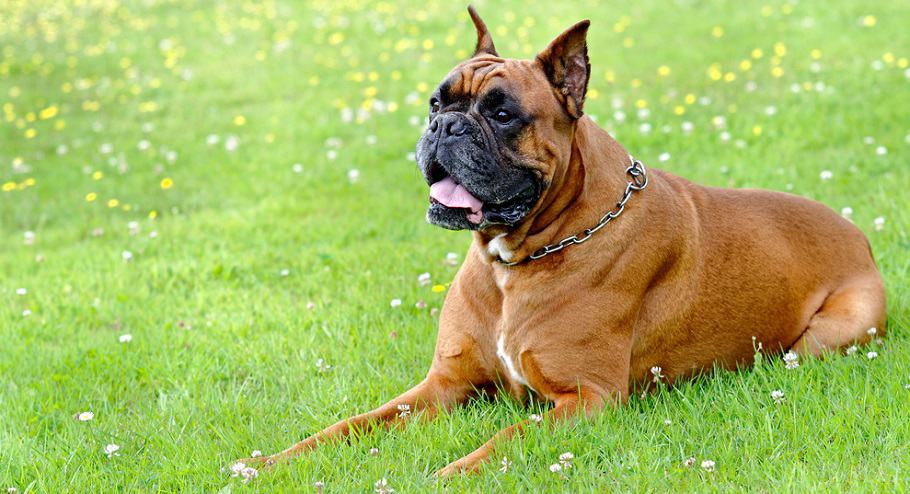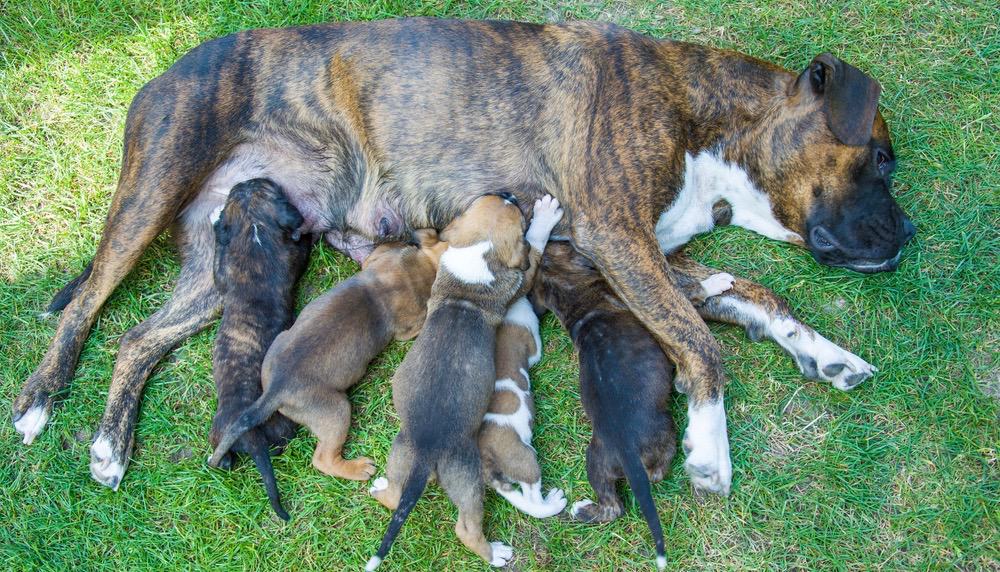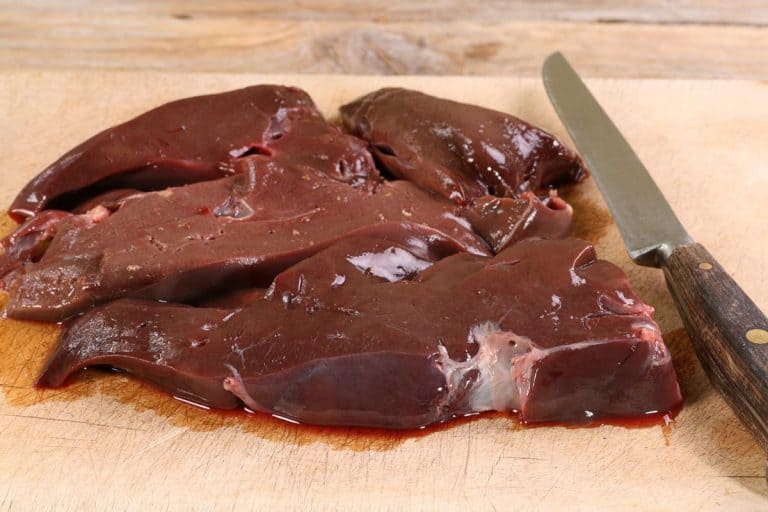Boxer Growth Chart (Weight & Size Chart) – When Do Boxers Stop Growing?
Watching your puppy grow up can be a satisfying feeling. However, although they may feel like they’ll be puppies forever, you might be wondering when do boxers stop growing?
Knowing when your boxer will be fully grown is important to prepare you for the different developmental stages and helping them reach their full size —and potential.
This article will give you information on the boxer growth chart and everything you need to know about boxers.
This will enable you to know when your boxer stops growing and their ideal weight and size so that you can monitor them accordingly—and know when something’s out of the ordinary!
When Do Boxers Stop Growing?

Understanding when your boxer will stop growing and the size they will be when an adult can help you avoid any surprises. This is because you will be able to look after the boxer well, set expectations, and prepare ahead of time.
In general, boxers stop growing in weight and height between 18 and 24 months.
On average, females reach 21 to 24 inches and 55 to 65 pounds, while males reach 22 to 25 inches and 60 to 70 pounds.
However, once boxers reach their adult size, they can increase in width until the age of 2 to 3 years. This is when they are considered to be fully matured and grown to adult weight and size.
Boxer Size Chart
The Boxer weight chart below details the expected weight of your boxer from birth through to adulthood. The expected weight generated is tracked from the birth weight.
Therefore, for boxers born at a heavier weight, the weight increases over time are expected to be higher than boxers born at a lighter weight.
The boxer size chart is an incredibly easy tracking tool to ensure that your beloved pooch is developing as he should.
Regularly tracking the weight of your dog is important as it can be the first and most obvious sign of where their health status is at.
It is also important to note that the growth and development of a puppy may be different compared to the expected weight stated on the chart—if this is the case, it is not necessarily a cause for concern.
While boxer growth can be broadly predicted from birth to 18 months, each puppy will have its own development path.
This should be considered when using the growth chart and give a degree of leniency for each development weight target.
You should only contact your vet if your boxer is radically over or under the expected weight compared to their age.
Boxer Weight Chart
| Age | Average lb | Average kg |
|---|---|---|
| 1 Weeks | 2.5 - 3.2 lbs | 1.2 - 1.5kg |
| 4 Weeks | 6.0 - 7.0 lbs | 2.5 - 3.0 kg |
| 8 Weeks | 17.0 - 19.0 lbs | 8.0 - 8.5 kg |
| 12 Weeks | 25.5 - 28.5 lbs | 11.0 - 13.0 kg |
| 16 Weeks | 35.5 - 40.0 lbs | 16.0 - 18.0 kg |
| 18 Weeks | 42.5 - 47.5 lbs | 19.0 - 21.5 kg |
| 22 Weeks | 50.0 - 55.0 lbs | 22.5 - 25.0 kg |
| 26 Weeks | 59.5 - 66.5 lbs | 27.0 - 30.0 kg |
| Adult | 66.5 - 70.0 lbs | 30.0 - 32.0 kg |
Boxer Growth Chart – What to Expect

Birth – 2 weeks
Boxers are considered large dogs and would be expected to weigh somewhere in the region of 2.5 lb to 3.2 lb at birth.
The 2-week period from birth then cues some pretty rapid growth development—anywhere between 80% to 100% increase from the birth weight.
After just their first 2 weeks, boxers can be expected to weigh anywhere between 4.5 lb to 5.5 lb. During this period, boxer puppies rely exclusively on their mother’s milk to stimulate the early brain and physical development.
3 weeks – 12 Weeks
In the 3-week to 12-week period, you’ll see another huge growth stage for boxer puppies. During this growth period, boxers can be expected to grow from 6 lb-7 lb to a range of 25.5 lb-28.5 lb – which amounts to around a 300% weight increase.
Boxer puppies tend to be weaned from around the 4-week stage. This change in diet to solid foods leads towards dramatic growth and weight gain. As boxers are a large breed, stronger appetites also contribute to large weight gain.
4 Months – 18 Months
From 4 months to 18 months, boxers can be expected to double their weight.
At 4 months, the weight of a boxer can vary from 35.5 lb to 40 lb while at 18 months,a boxer can weigh anywhere between 60 lb to 70 lb.
This period sees a dramatic transition for boxers from puppies to fully grown adults. In addition to weight gain, boxers also become increasingly independent and curious.

Adult
The 18-month weight is the expected full adult weight of a boxer. Boxer owners should keep a note of this weight range and regularly monitor their boxers.
If they start to slip outside of this range, owners should contact a vet for further monitoring as sudden weight gain or weight loss could be a sign of ill-health or a need for a change in diet or exercise regime.
How Big Do Boxers Get?

If you are looking at your Boxer puppy and trying to visualize how big do Boxers get, there are methods that can help you get a good guess.
The first is if you already know the pup’s parents, you can look at them and see how large they are. If they are big, your pup will likely be big. A DNA test might be able to give you the same insight.
You can also look at your puppy’s paws. This will not give you an exact size to look for, but you can have a good idea of how much growing he has left to do.
When Is A Boxer Fully Grown?
It can be hard to imagine when your puppy will reach his final size, but it will happen eventually.
The Boxer breed is a larger dog breed and needs a little bit more time to fully fill out than other dogs might need. Your Boxer might take 18 to 24 months to finish growing and filling out.
Your Boxer will likely reach his final height by around a year, but continue to thicken and gain weight for another year. He might look a little lanky and awkward until he is done growing, with long slender limbs.
Will Neutering/Spaying Affect My Boxer’s Growth?
It is highly recommended by vets everywhere that you spay or neuter your dog in order to prevent unwanted pregnancy, to help with any unwanted behaviors, and even for their health and well-being.
But, a common concern is whether spaying or neutering your Boxer as a puppy will affect his growth.
In truth, spaying or neutering your dog will not stunt his growth. He will still achieve his natural height regardless.
It has been shown to negatively affect a dog’s growth plates in his joints, however. Spaying or neutering your Boxer before he has finished growing can cause joint issues in the future.
How To Properly Weigh And Measure A Boxer
Keeping track of your puppy’s weight is good to make sure that your puppy is staying on his growth curve. You should be weighing your puppy every week.
If your puppy is small enough, or you are strong enough, you can use your home scale to weigh him. First, weigh yourself and write it down. Then, pick up your puppy and get back on the scale. The difference between the two weights is your puppy’s weight.
As your puppy gets bigger, you might need to go to the vet’s office and have them weigh your puppy, unless you want to invest in a large scale for your home.
What Is A Boxer’s Neck Size?
It might not seem like something that you just would know, but you should know what your Boxer’s neck size is. You should also know that if you have a Boxer puppy, his neck size is naturally going to change over time.
Knowing his neck size is essential in knowing that you have the most appropriate collar for your puppy.
To measure your dog’s neck, you need to use a tape measure. Using inches, measure the circumference of your dog’s neck lower down, which you can then compare to the collar you are buying.
An adult Boxer’s neck is between 16 and 22 inches, but the puppy’s neck is going to be smaller. Check your puppy’s collar regularly to make sure it still fits.
Boxer Body Condition Score (BCS)
If you are trying to keep track of your Boxer’s weight to make sure that he is the right size, there is a handy guide that you can look at.
Whether a dog’s weight is appropriate is gauged using a system called the Body Condition Score or BCS. The scale works off of a number system from 1 to 9.
A 1 on the scale means the dog is incredibly underweight and unhealthy. His ribs would be poking out and he not only has no fat but no muscle either.
On the other end, a 9 means the dog is severely obese with fat deposits all over. He will bulge out at the sides.
The ideal score is a 5, which means he looks thin enough to see his waist from above and you can feel his ribs under his fur, but not so thin that you can see them.
How To Help Your Boxer Lose Weight If He Is Overweight
If you have looked at your dog’s BCS score and determined that he is overweight, or your vet has stated that your dog is overweight, there are some strategies that you can use to help your dog reach a better weight.
- What are you feeding him? You really need to look at what you are feeding your Boxer. They are not prone to obesity so if yours is obese, how did that happen? A lot of common dog foods have fillers and fat that are not good for your dog. You might also be giving him too much food, so check on the calories that he is consuming as well.
- What about people food? Are you feeding your Boxer off of your plate? Some human food for dogs is acceptable, but not prepared dishes that you were going to eat yourself. That can definitely contribute to weight issues.
- Is he getting exercise? Finally, how much exercise is your Boxer getting? They need a lot of exercise, so if he is cooped up all day, that needs to change.
Boxer Body Shape Changes
Naturally, boxer puppies are a bit round, but they quickly grow. When a boxer is between the age of 1 and 2 years, they grow in height very fast and cannot keep up with the weight. This can lead them to be skinny but this lasts for a short time.
Adult boxers are strong and lean. When boxers mature, their chest widens, fills out, and becomes a focal point. The legs become long and the flanks are lean, this gives them a good profile.
Their appearance is sleek and strong because their muscles are visible due to their short and packed coat.
Factors That Affect Boxer Puppy Growth

Understanding our boxer growth chart can help you in giving them a better lifestyle in terms of diet, nutrition, and exercise. The following factors affect the growth of a boxer puppy:
Genetics
As a boxer puppy owner, you should get information about your puppy’s parents and grandparents. This is because genetics play an important role in the growth of dogs as well.
Knowing the ideal weight and size of the parents and grandparents will give you an idea of the ideal growth parameters of your new puppy. This will also prepare you for any growth changes that may happen in the future.
Nutrition
The diet that you give to your boxer is very important because it will affect their weight and general health.
Ensure that the food you give to your puppy is free from unhealthy fillers, free from grains, and is the best food for a Boxer puppy available.
Be careful when you are giving them scraps to avoid overfeeding them. If your boxer is overweight during their puppy stages, it can be hard to reduce because of their limitations in activities.
Physical Activity
Boxers are playful dogs hence the need for an exercise routine for optimal health. Giving your puppy space to run around and playing fetch with them until they are tired is enough.
However, do not take them jogging or running until their bones have grown properly. This is because the excessive impact of exercising may cause damage to the long bones leading to abnormal development. This can make your puppy have joint problems in the future.
How Long Are Boxers Pregnant?
On average, boxers take 60 to 75 days to go from conceiving to having her puppies. It is important to take care of her as soon as she gets pregnant.

You may think that your boxer got pregnant due to an unplanned tie, but noticing the signs as soon as possible is necessary. The signs include:
- Her nipples will become bigger and new nipples will emerge.
- If your boxer is not overweight, they will quickly show a bump on their stomach.
- Her appetite may reduce and by week 3 they have a heartier appetite.
- Her moods may change, for example, wanting to be left alone rather than play.
- She may start showing dominance.
How Many Puppies Do Boxers Have?
In their first litter, a boxer dog can have between 8 and 11 puppies depending on their health, how well they are fed, weather and age. It takes almost 2 to 3 years for the litter of puppies to properly mature.
Taking good care and feeding the puppies well immediately after birth will allow the mother to feel safe and not fear losing any of her puppies.
What If My Boxer Is Not The Right Weight?
Your boxer should stay in shape to avoid health issues related to weight. There are different things that can contribute to your boxer being overweight including limited exercising, pet food that is low in quality, a lot of treats, and health issues such as thyroid disease.
It is important to recognize when your boxer adds weight so that you can adjust their lifestyle and take them to the vet to be checked out.
Signs that your boxer is overweight include: you cannot feel the ribs, the body doesn’t have definition and your boxer is panting just after a few minutes of exercise.
On the other hand, your boxer may be too skinny for their size. If you can see the ribs of your boxer, it means they are underweight.
Feed them enough food especially if they are exercising. However, if their weight does not increase take them to the vet as there could be an underlying problem.
What Is The Life Expectancy Of A Boxer?
Generally, larger dogs including boxers have a shorter life expectancy compared to smaller breeds. Boxers may not be considered as huge breeds but since cancer, the average life expectancy of a boxer is between 10 to 12 years.
These canine dogs can live up to a maximum age of mid-teens, but not many boxers have been recorded to live up to this age.
How Much Does It Cost To Own A Boxer?
The average cost of a boxer puppy is between $700 to $2000. If the puppies have been dewormed and vaccinated, it may cost more. When purchasing a boxer puppy, ensure that you receive all the required paperwork.
The cost of owning a boxer depends on the breeder’s authority, pedigree, and the details of vaccination.
However, you can get a boxer dog at a much lower cost from adoption and rescue agencies. The whole process may be between $300 and $400.
Boxer Genetics And Common Health Problems
All dogs can suffer from some health issues. Boxers are naturally athletic hence healthy; however, they can be affected by health conditions or complications. If you notice that your boxer shows symptoms of illnesses, take them to the doctor for early diagnosis.
The following are the possible health problems that may affect your boxer:
Hip Dyslexia
This disease mostly affects the larger breed of dogs. It is caused by the abnormal formation of the hip socket and the symptoms include noticeable avoidance of hind legs, limping when walking normally, visible pain during climbing the stairs, difficulty to run and walk, and reluctance to exercise.
Bloat
Also known as gastric bloat, this disease causes a twist or tear in the stomach. The stomach is filled with excess air, gas, and liquid that the dog is unable to expel. The blood flow to the heart is then affected by the increase in pressure.
Symptoms include restlessness, shortness of breath, vomiting, and drooling. Gastric can be fatal, therefore, if you notice any of the symptoms take them to the vet.
Acne
Boxer puppies also suffer from beauty problems such as acne and pimples. During playtimes, dogs can scratch and wound the pimples which can lead to scarring or even skin infection.
Arthritis
This issue normally starts at the beginning of old age. Understand the symptoms of this disease and take your boxer to the vet so that they do not stay in pain.
Cancer
This is the most dangerous disease that can affect your boxer puppy and the common types are brain tumors and lymphoma.
Conclusion
Our boxer weight chart will give you the ideal weight for your puppy so that you will know whether they are underweight or overweight.
Also, knowing the potential health problems that may affect your boxer will prepare you in case they get affected. Hopefully, the above article has given you the information that you need to understand the growth of your boxer puppy.








